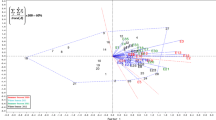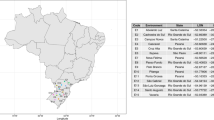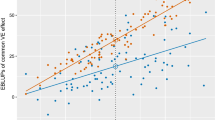Abstract
The objective of this study was to propose a methodology using a factor analysis associated with genotypic and genotype × environment interaction effects (FGGE) and to accomplish, simultaneously, analyses of environmental stratification and the adaptability of maize cultivars indicated for planting in Paraná State. The analysis of adaptability based on the factor analysis was accomplished graphically by scoring in relation to the factors with separation in the adaptability quadrants. The analysis of environmental stratification were accomplished beginning with the magnitude of the final factor loadings obtained after rotations through the varimax method. The FGGE method is efficient for processing the environmental stratification and adaptability analysis. More than 70 % of the retained variation in the first eigenvalues represents the expressive part of the sum of the genotypic and genotype × environment interaction (G × E) interaction effects for this data set. The cultivars with wide adaptation and high yield in the group of the tested environments were P30F35, P30F53, P30K64, P30R50 and AS 1570.



Similar content being viewed by others

References
Acquaa G, Adams MW, Kelly JD (1992) A factor analysis of plant variables associated with architecture and seed size in dry bean. Euphytica 60:171–177
Crossa J, Cornelius PL (1997) Sites regression and shifted multiplicative model clustering of cultivar trial sites under heterogeneity of error variances. Crop Sci 37:405–415
Crossa J, Gauch HG, Zobel RW (1990) Additive main effects and multiplicative interaction analysis of two international maize cultivar trials. Crop Sci 30:493–500
Crossa J et al (1991) AMMI adjustment for statistical analysis of an international wheat yield trial. Theor Appl Genet 81:27–37
Cruz CD, Carneiro PCS (2006) Modelos biométricos aplicados ao melhoramento genético, vol 2. UFV, Viçosa, p 585
Duarte JB, Vencovsky R (1999) Interação genótipos x ambientes: uma introdução a análise “AMMI”. Sociedade Brasileira de Genética, Brasil
Duarte JB, Zimmermann MJO (1995) Correlation among yield stability parameters in common bean. Crop Sci 35:905–912
Duvick DN (1999) Heterosis: feeding people and protecting natural resources. In: Pandey S, Coors JG (eds) The genetics and exploitation of heterosis in crops. ASA, Madison, pp 19–29
Ferreira DF (2008) Estatística multivariada Ed. UFLA, Lavras
Fritsche-Neto R et al (2010) Factor analysis and SREG GGE biplot for the genotype × environment interaction stratification in maize. Ciência Rural 40:1043–1048
Garbuglio DD et al (2007) Análise de fatores e regressão bissegmentada em estudo de estratificação ambiental e adaptabilidade em milho. Pesquisa Agropecuária Brasileira 42:183–191
Gerage AC, Shioga PS, Araujo PM. (2006) Avaliação estadual de cultivares de milho safra 2005/2006, No. 150. IAPAR, Londrina
Gould SJ (1996) The mismeasure of man. W. W. Norton, New York
Granate MJ et al (2001) A análise de fatores na predição de ganhos por seleção em milho (Zea mays L.). Acta Scientiarum 23:1271–1279
Houmayoun H (2011) Study of some morphological traits of corn hybrids. American-Eurasian J Agric Environ Sci 10:810–813
Juvik JA et al (1993) Kernel changes in a shrunken-2 maize population associated with selection for increased field emergence. J Am Soc Hortic Sci 118:135–140
Kang MS, Gauch Júnior HG (1996) Genotype by environment interaction. CRC, New York
Khavari Khorasani S et al (2011) Multivariate analysis of agronomic traits of new corn hybrids (Zea maiz L.). Int J AgriSci 1:314–322
Lin CS (1982) Grouping genotypes by a cluster method directly related to genotype-environment interaction mean-square. Theor Appl Genet 62:277–280
Mendonça O et al (2007) Análise de fatores e estratificação ambiental na avaliação da adaptabilidade e estabilidade em soja. Pesquisa Agropecuária Brasileira 42:1567–1575
Munaro LB et al (2014) Brazilian spring wheat homogeneous adaptation regions can be dissected in major megaenvironments. Crop Sci 54:1–10
Murakami DM, Cruz CD (2004) Proposal of methodologies for environment stratification and analysis of genotype adaptability. Crop Breed Appl Biotechnol 4:7–11
Rakshit S et al (2012) GGE biplot analysis to evaluate genotype, environment and their interactions in sorghum multi-location data. Euphytica 185:465–479
Ramos LM, Sanches A, Cotes JM (2009) Testes multiambientais na seleção de genótipos de arroz utilizando o modelo de regressão nos sítios ou locais. Ciência Rural 39:52–57
Robertson A (1959) Experimental design on the measurement of heritabilities and genetic correlations: biometrical genetics. Pergamon Press, New York
Rocha MM (2002) Seleção de linhagens experimentais de soja para adaptabilidade e estabilidade fenotípica. Thesis, Universidade de São Paulo/Escola Superior de Agricultura Luiz de Queiroz
Rocha MM, Vello NA (1999) Interação genótipos e locais para rendimento de grãos de linhagens de soja com diferentes ciclos de maturação. Bragantia 58:69–81
Rolins JA et al (2013) Variation at the vernalisation genes Vrn-H1 and Vrn-H2 determines growth and yield stability in barley (Hordeum vulgare) grown under dryland conditions in Syria. Theor Appl Genet 126:2803–2824
Rossi RR, Benin G (2012) Biplot analysis: concepts, interpretations and uses. Ciência Rural 42:1404–1412
Shioga PS, Gerage AC, Araujo PM (2007) Avaliação estadual de cultivares de milho safra 2006/2007, No. 152. IAPAR, Londrina
Soto-Cerda BJ et al (2014) Assessing the agronomic potential of linseed genotypes by multivariate analyses and association mapping of agronomic traits. Euphytica 196:35–49
Troyer AF (2006) Adaptedness and heterosis in corn and mule hybrids. Crop Sci 46:529–543
Troyer AF, Wellin EJ (2009) Heterosis decreasing in hybrids: yield test inbreds. Crop Sci 49:1969–1976
Von Korf M (2008) Quantitative trait loci associated with adaptation to Mediterranean dryland conditions in barley. Theor Appl Genet 117:653–669
Wan Y, Qian Y, Migliaccio KW, Li Y, Conrad C (2014) Linking spatial variations in water quality with water and land management using multivariate techniques. J Environ Qual 43:599–610
Yan W et al (2000) Cultivar evaluation and mega-environment investigation based on the GGE biplot. Crop Sci 40:597–605
Author information
Authors and Affiliations
Corresponding author
Rights and permissions
About this article
Cite this article
Garbuglio, D.D., Ferreira, D.F. FGGE method: description and application in data from maize cultivars. Euphytica 204, 723–737 (2015). https://doi.org/10.1007/s10681-015-1375-6
Received:
Accepted:
Published:
Issue Date:
DOI: https://doi.org/10.1007/s10681-015-1375-6



